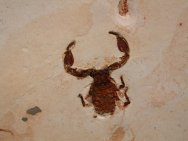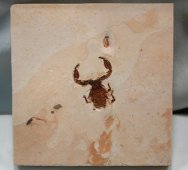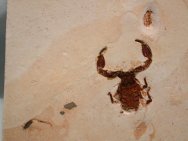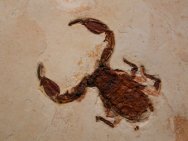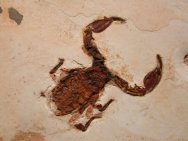| Name:
Araripescorpius laibuuei
Arachnida;
Scorpiones; Protoischnuridae
Geologic
Time: Lower Cretaceous
Size (25.4mm=1
inch): 33 mm long, 25 mm across. Matrix: 115 mm by 115 mm.
Fossil Site:
Santana Formation, Crato Member, Chapado do Araripe, Ceara, Brazil
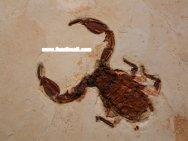 Description:
This fine fossil specimen shows a scorpion with preserved pedipalps
and body. Little material from this treasure trove ever becomes
available, with scorpions one of the most rare of fossils. The fossil
record for scorpions extends back to the Silurian some 400 million
years ago. By 110 million years ago, they closely resembled their
modern-day counterparts, as can be seen here. Examples from the
Mesozoic and Tertiary are quite rare, making this a highly-desired
specimen. While missing the abdomen, this is a most affordable example;
complete ones command in excess of $2000. Interestingly, modern-day
scorpion hunters use UV light to collect the fluorescent scorpions
at night. Although this one is over 100 million years old, exposure
to UV will cause this one to glow faintly with an eerie greenish-yellow
light. Description:
This fine fossil specimen shows a scorpion with preserved pedipalps
and body. Little material from this treasure trove ever becomes
available, with scorpions one of the most rare of fossils. The fossil
record for scorpions extends back to the Silurian some 400 million
years ago. By 110 million years ago, they closely resembled their
modern-day counterparts, as can be seen here. Examples from the
Mesozoic and Tertiary are quite rare, making this a highly-desired
specimen. While missing the abdomen, this is a most affordable example;
complete ones command in excess of $2000. Interestingly, modern-day
scorpion hunters use UV light to collect the fluorescent scorpions
at night. Although this one is over 100 million years old, exposure
to UV will cause this one to glow faintly with an eerie greenish-yellow
light.
|
|

